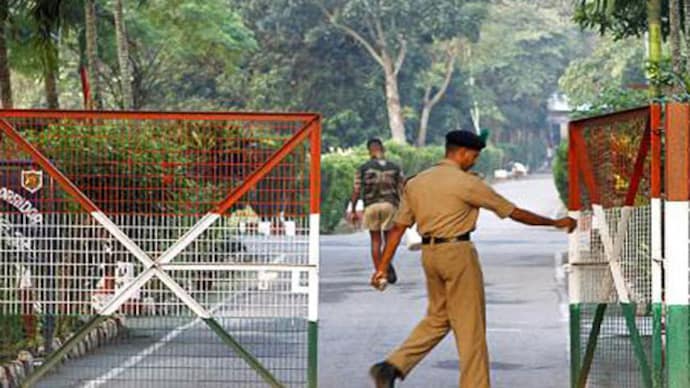India-Bangladesh Enclaves: Where Bangladesh hoists the tricolour
It is an ideological return to a semblance of a homeland that the residents of the India-Bangladesh enclaves will finally be gifted with, once the Land Boundary Agreement is signed by Narendra Modi and Sheikh Hasina, the prime ministers of India and Bangladesh respectively, this weekend.

In the 571.38 acres of Bangladeshi land called Dakshin Masaldanga, the likes of Belal Hossain and Saher Ali have been hoisting the Indian tricolour on January 26 and August 15 every year. A Bangladeshi exclave in the district of Cooch Behar, West Bengal, this fragment of land is Bangladesh on paper, yet India in spirit. It is a piece of Bangladeshi land, locked within the Indian mainland. Much like the 50 other Bangladeshi chhits (enclaves) in India. In Bangladesh, there are 111 Indian enclaves.
For years, the residents of this Bangladeshi enclave, Dakshin Masaldanga, have been celebrating every Indian National Holiday with unparalleled gusto. For years, these chhitmahalis (enclave-dwellers) have been dreaming of hoisting the Indian tricolour as Indian citizens, not as the children of a No Man's Land.

This deferred dream will finally see the light of the day as Indian Prime Minister Narendra Modi and Bangladeshi Prime Minister Sheikh Hasina sign the Land Boundary Agreement this weekend. While the tentative date of sealing the land pact is June 6, in the hearts of the chhitmahalis, there is no hint of suspicion. Despite years of postponement of the deal, seeing the Dahagram-Angarpota enclaves connected via the Tin Bigha corridor while their own fate hung in a limbo, the residents of Masaldanga, Powatorkuthi, Bakalirchhara, Batrigachh, et al haven't lost hope. It is this flickering ray of hope that has kept the Chhitmahal Binimoy Samanway Samiti (Enclave Exchange Coordination Committee) soldiering on for so long. The residents of the Indian and Bangladeshi enclaves have all been united in this mission of sorts, the realisation of which is just a few days away now.
ALSO READ: Life in the islands on land
The happenings in the echelons of power in New Delhi and Dhaka need a while to travel to these chhitmahalis' lives. Hence, it was only after a couple of days that the residents of both the Indian and Bangladeshi enclaves erupted in joy at the news of the enclave-exchange pact finally turning into reality. In the Bangladeshi chhits, people have been celebrating what is undoubtedly the best phase of their broken lives. The fragmented sky above the heads of these humans is dressed in rainbow colours today. The air is fragrant with the scent of gulaal, and the occasion has a roshogolla-sondesh flavour to it. These Bangladeshi chhitmahalis are busy thanking their fates that they are finally being granted Indian citizenship and not being shifted to the Bangladeshi mainland.

"We'd never imagined, even in our dreams, that we'd finally be Indian citizens someday," is more or less the emotion every chhitmahali in these enclaves is echoing these days.
For half a century, the inhabitants of the India-Bangladesh enclaves have spent severely fragmented lives, devoid of the rights and liberties every country ensures its citizens have. Since their lives were locked within an alien country, one that the land they resided in was physically situated in, they were never treated as a citizen of their own country. So, while the people in the Bangladeshi enclaves in India are termed 'Bangladeshis', they have spent their entire lives locked within India, and vice versa.
Most of these people have just a vague notion of the country called Bangladesh, and haven't even seen the Bangladeshi mainland in their lives. They attend Indian schools in the Indian mainland, under the guardianship of surrogate fathers, while their real ones live a life of misery for being a 'chhitmahali'. They get their daily supplies from Indian markets, and in case of emergencies, they travel to the nearby hospitals in the Indian mainland. None of the enclaves has any health facility, markets, tube-wells, schools, nothing. It is a life no one would want to live. But for close to sixty years, since the Indian independence, the chhitmahalis have had to live a life not of their own choosing.

It is this wrong, which had been committed several years back, that the Land Boundary Agreement will finally help right. It is an ideological return to a semblance of a homeland that the people will finally be gifted with, once the land pact is signed by the heads of India and Bangladesh this weekend. It is an existential battle that will finally see the fruits of perseverance and patience. It is these half-lives that the Land Swap Bill will help transform.
And once the exchange of enclaves is completed, these people will be able to hoist the tricolour with as much pride as an Indian citizen does on any occasion whatsoever. It will no longer be a tale of imagined homelands that the newer generations of chhitmahalis are forced to deal with every day of their lives. It is a scene of jubilation in these enclaves today; a celebration that has the Indian flag fluttering sans any doubt in any of the hoisters' minds. The likes of Belal Hossain and Saher Ali, will after all, soon be Indian citizens on paper, too.
